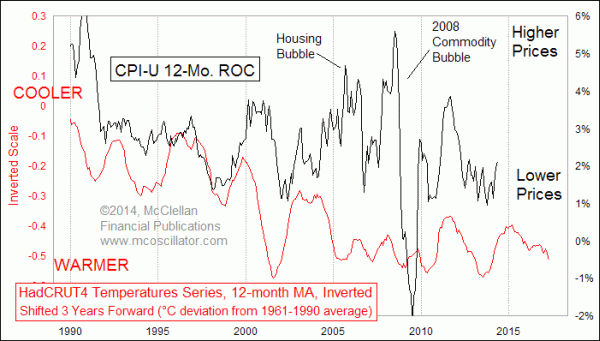Inflation Arriving For A Short Stay

Free Chart In Focus email
Delivered to you every week
Back in September 2013, I wrote about a unique new way to forecast inflation. That piece called for a pickup in inflation, which has materialized, and so it is worth taking another look to see what more is ahead.
The unique idea is that global temperatures give us a 3-year leading indication for what inflation rates are going to do. The relationship does not do it perfectly, just really well. This week's chart zooms in closer on the relationship I introduced in that September 2013 article. It reveals that the recent uptick in CPI inflation, which has economists so worried, is right on schedule according to what the temperature data have been saying. The rising rate of inflation should continue into around January 2015, after which we should see the inflation rate gradually waning again.
As with that earlier article, the raw global temperature data are from the United Kingdom's Hadley Centre Climate Programme, available here. And the CPI inflation rate data are from the Bureau of Labor Statistics' (BLS) web site, available here:
Looking at that chart above, it can be hard to see the nice correlation which exists most of the time because the 2008 commodities bubble and subsequent collapse tend to occupy the mind's focus. So here is that same chart with that anomaly taken away, allowing us to better see what the correlation looks like absent that big 2008 anomaly:
.gif)
Some people might take exception to cutting out a chunk of data that I don't like, and I am sympathetic to that viewpoint. I don't like it either. But I liken it to evaluating the surf forecast for a Southern California beach on the day when the asteroid lands in the ocean. The tsunami which results from the asteroid does not invalidate the legitimacy of the original weather-based forecast; the meteorologists giving the surf forecast understandably cannot possibly forecast the arrival of the asteroid.
Similarly, the effect of global temperatures on agricultural production (which I believe drives this relationship with prices) cannot be blamed for not modeling the effects of a Fed-fueled commodities bubble and subsequent collapse. That was a human psychology event, not a market-based supply/demand event.
What this model shows for the immediate future is a continued rise for CPI inflation into the end of 2014, which will probably get Wall Street worrying about the specter of looming "hyper-inflation" and other concerns. But then 2015-2016 should see gradually declining inflation rates as the echo of warming years in 2012-13.
Tom McClellan
Editor, The McClellan Market Report
Sep 19, 2013
A Cooling Planet Means Price Inflation |
Jun 19, 2014
Crude Oil Abnormally Quiet |
Mar 21, 2014
Gold Bugs Cheer The Rain |